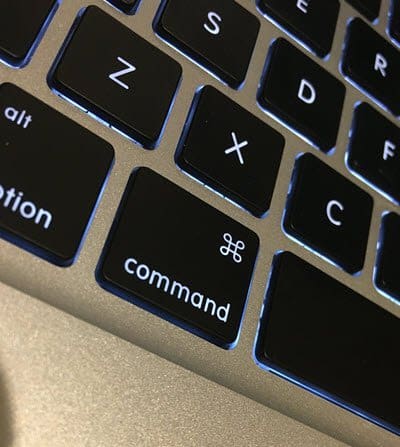- Secure Boot prevents booting an unsigned Bootloader from any internal disk or USB drive. Secure boot is not supported by Clover or OpenCore. Secure Boot must be disabled in UEFI BIOS to boot from a Hackintosh. To Disable Secure Boot Just “Clear Secure Boot Keys” or delete PK Keys.
- Attention to all users, please note this guide and other khronokernel sites will be shutting down on April 16th, 2020. Reason for this is we've decided to move the guides to a dedicated organization to help simplify the hackintosh process and provide a single, trusted source for hackintosh information. This new organization will be known as.
What’s up guys, in this tutorial I’m going to show you How to Create Bootable USB Installer for macOS High Sierra Windows 10 Operating System. There are few applications that you need to download in-order to successfully create a bootable USB Flash Drive to install macOS High Sierra Windows 10 PC.
Yevgen is using the UTM app to run virtual machines on iOS devices, then has employed a process to create a virtual Hackintosh with a method shared on GitHub called OSX-KVM. KVM is an open source. Continuing our Hackintosh guides journey, here we present the Easiest way to create Hackintosh for the Latest OS X iteration: Mountain Lion. We had been working hard while experimenting different ways by which you could hackintosh a Mountain Lion on a PC. It took us a while, but after testing all possible methodologies, here’s the easiest one for you. If you’re new to hackintosh world.
Firstly, you need to download TransMac application as we will use this to write files onto flash drive. Once you have downloaded and installed TransMac, run the application.
TransMac is a Paid Application. But the trial period will last for 15 days, this is more than enough for us to Create Bootable USB Installer for macOS High Sierra Windows 10.
Before you click Run, just make sure you have plugged-in your 16 GB USB Flash Drive.
Now, Click Run and proceed with the trial of 15 Days. You should see the following screen once you click Run.
Right-Click on your USB Flash Drive and select the option Format Disk for Mac.
When the warning pops-up click Yes.
TransMac will now ask you to name your ISB Drive. I will name my USB Drive as “USB Installer“, but you can name it anything you like. After you Name the USB Drive click OK.
Click Yes, when TransMac will give you the Overwrite warning.
Now, just wait for few moments, as the formatting process is going on.
Once the formatting is successfully completed you should get this following confirmation. If it is not a success, please follow the steps again and format your flash drive.
Click Ok, and now right-click on your USB Flash Drive again and select the option Restore with Disk Image.
Click Yes, when TransMac gives you a warning for Overwriting.Next Step is to Select the dmg file for macOS High Sierra. You would need an Mac to download the macOS High Sierra Installation file from Apple Store.
To locate the DMG File, follow these steps
 After you have downloaded the High Sierra app, locate the InstallESD.DMG from the installer.
After you have downloaded the High Sierra app, locate the InstallESD.DMG from the installer.In Applications folder: Right-click on Install MacOS High Sierra app, then choose Show Packages Contents to reveal Contents folder.
The MacOS High Sierra InstallESD.DMG is found under: Contents/SharedSupport/
Now copy this InstallESD.DMG as you need it in TransMac to Create macOS High Sierra Bootable USB Installer on Windows 10.
Ok, so lets continue with TransMac Restore Disk Image to Drive. On this screen, select the InstallESD.DMG file and click OK.
Click Yes, when TransMac Gives you the Overwrite warning.
Now the TransMac will start the process of Restoring High Sierra Image on the Flash Drive. this will take 15-25 minutes, depending on the speed of your flash drive.
 Ok that should be it for this tutorial on How to Create macOS High Sierra Bootable USB Installer on Windows 10 PC.https://techhowdy.com/high-sierra-bootable-usb-installer-on-windows-10/https://techhowdy.com/wp-content/uploads/2018/05/Create-macOS-High-Sierra-Bootable-USB-Installer-on-Windows-10-1024x641.jpghttps://techhowdy.com/wp-content/uploads/2018/05/Create-macOS-High-Sierra-Bootable-USB-Installer-on-Windows-10-150x150.jpgHackintosh TutorialsCreate macOS High Sierra Bootable USB Installer,Create macOS High Sierra Bootable USB Installer on Windows,Create macOS High Sierra Bootable USB Installer on Windows 10,High Sierra Bootable USB Installer on Windows 10,macos high sierra bootable usb,macos high sierra bootable usb download,macos high sierra bootable usb from windows,macos high sierra bootable usb installer,macos high sierra bootable usb terminal,macos high sierra bootable usb windowsWhat's up guys, in this tutorial I'm going to show you How to Create Bootable USB Installer for macOS High Sierra Windows 10 Operating System. There are few applications that you need to download in-order to successfully create a bootable USB Flash Drive to install macOS High Sierra Windows...DemonLyoidLopeslyoid_lopes@yahoo.comAdministratorHi there, I am Lyoid Lopes. Internet Marketer and Blog writer. I am Software Engineering Technology graduate from Centennial College Canada. In Techhowdy I publish new technology news every day. You can reach me Facebook, Twitter and Google +TechHowdy
Ok that should be it for this tutorial on How to Create macOS High Sierra Bootable USB Installer on Windows 10 PC.https://techhowdy.com/high-sierra-bootable-usb-installer-on-windows-10/https://techhowdy.com/wp-content/uploads/2018/05/Create-macOS-High-Sierra-Bootable-USB-Installer-on-Windows-10-1024x641.jpghttps://techhowdy.com/wp-content/uploads/2018/05/Create-macOS-High-Sierra-Bootable-USB-Installer-on-Windows-10-150x150.jpgHackintosh TutorialsCreate macOS High Sierra Bootable USB Installer,Create macOS High Sierra Bootable USB Installer on Windows,Create macOS High Sierra Bootable USB Installer on Windows 10,High Sierra Bootable USB Installer on Windows 10,macos high sierra bootable usb,macos high sierra bootable usb download,macos high sierra bootable usb from windows,macos high sierra bootable usb installer,macos high sierra bootable usb terminal,macos high sierra bootable usb windowsWhat's up guys, in this tutorial I'm going to show you How to Create Bootable USB Installer for macOS High Sierra Windows 10 Operating System. There are few applications that you need to download in-order to successfully create a bootable USB Flash Drive to install macOS High Sierra Windows...DemonLyoidLopeslyoid_lopes@yahoo.comAdministratorHi there, I am Lyoid Lopes. Internet Marketer and Blog writer. I am Software Engineering Technology graduate from Centennial College Canada. In Techhowdy I publish new technology news every day. You can reach me Facebook, Twitter and Google +TechHowdy Setting up Mac OS X on a PC carries its own inherent risks; despite the fact that Hackintoshes are generally very stable, there's always a chance that your computer will fail to start, for whatever reason. In these cases, your best option may be to temporarily boot Mac OS X with the help of a boot USB drive. From there, you can fix whatever problem your Hackintosh is experiencing. Your Mac OS X installer USB drive can act as backup boot USB drive, but if you don't have yours anymore, you're not out of luck-- you can still create a makeshift boot USB drive on Windows instead.
Setting up Mac OS X on a PC carries its own inherent risks; despite the fact that Hackintoshes are generally very stable, there's always a chance that your computer will fail to start, for whatever reason. In these cases, your best option may be to temporarily boot Mac OS X with the help of a boot USB drive. From there, you can fix whatever problem your Hackintosh is experiencing. Your Mac OS X installer USB drive can act as backup boot USB drive, but if you don't have yours anymore, you're not out of luck-- you can still create a makeshift boot USB drive on Windows instead.Requirements
Hackintoshes generally use Chameleon or Chimera bootloader (they're really the same thing) to boot Mac OS X. If you own a real Mac, you can just download the PKG installer for Chameleon bootloader and install it onto a USB drive in a single click. However, on Windows, the process is more complicated. In this guide, we will be manually writing the necessarily bootloader files from Chameleon onto a USB drive through a series of command-line tools in Windows. Here's what you'll need:
- An empty USB drive - This USB drive can be any size; it doesn't really matter, since the Hackintosh bootloader will only take up a few megabytes. We'll be erasing this drive, so make sure you back up any files that you have on it.
- Chameleon boot sector files - A collection of command-line tools that you'll need to create a boot USB drive in Windows.
- 'boot' file - The main boot file that Chameleon bootloader will need to start Mac OS X. This file was extracted from the newest version of Chameleon bootloader (as of July 1st, 2013), and can boot any version of Mac OS X, including OS X 10.9 Mavericks.
- 'Extra' folder - A collection of additional kexts and configuration files necessary to get Chameleon bootloader working properly with Mac OS X. This folder should allow most standard Hackintosh setups to boot properly, though you can add your own specific kext files if you wish.
In the Command Prompt, enter the following command:
Hackintosh Usb Stops Working
Hackintosh Usb C
Replace 'Username' with your Windows username (include the quotation marks). In the screenshot below, I've replaced my Windows username with a blank line. This command changes the folder that the Command Prompt is working on (cd stands for 'change directory'). Now, everything you type into the Command Prompt will apply to the files in the Chameleon_BS folder. This assumes that you put the Chameleon_BS folder on the desktop-- if you put it somewhere else, you may edit the command appropriately. Next, enter the following command:
makeusb Letter:
Replace 'Letter' with the actual letter of your USB drive (don't include the quotation marks). In the screenshot below, the letter of my USB drive is 'O'. This command sets up the USB drive so that it'll be ready to boot Mac OS X.
Once the Command Prompt finishes working (it'll probably only take a few seconds), eject your USB drive from your computer. Then, plug the USB drive in again; this is necessary to get Windows to recognize your newly set-up USB drive properly.
3. Copy the boot files onto the USB drive
Finally, you'll need to copy several extra boot files onto the USB drive. Download the 'boot' file and 'Extra' folder; these are necessary files for the Mac OS X startup process.
DOWNLOAD: 'boot' file
DOWNLOAD: 'Extra' folder
The 'Extra' folder will be stored inside a ZIP file. Double-click on the ZIP file to open it. Copy the 'Extra' folder into your USB drive. Next, download and copy the 'boot' file onto your USB drive as well.
This completes the setup process. Now you should have a working Chameleon boot USB drive that can help start Mac OS X on most PCs. Congratulations!
NOTE: When attempting to boot Mac OS X with the help of a boot USB drive, make sure that USB drives are set to first priority in your computer's BIOS (Step 4 of our standard Mountain Lion installation guide).
SOURCE: [GUIDE]Creating a Chameleon Bootable USB from Windows
Hackintosh Usb Audio
